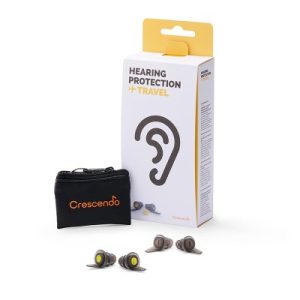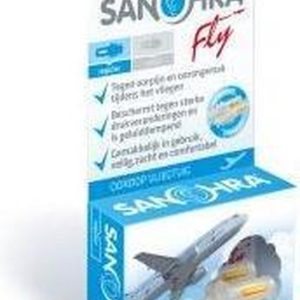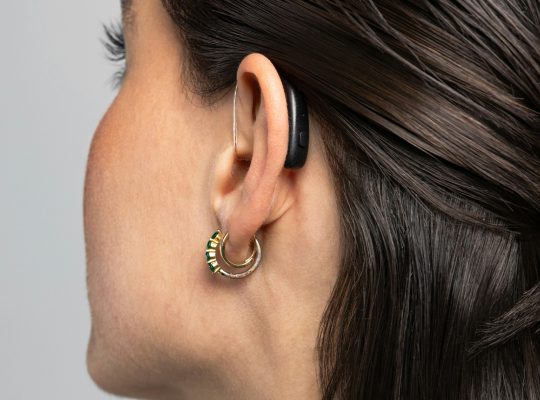Plane tickets booked? Passport at the ready? Wonderful, your vacation begins at the airport. But there is one thing many people (unconsciously) dread while flying: earache. Or rather, the annoying feeling of pressure on your ears as the plane ascends and descends. For some people it is merely irritating, but for others downright painful. Fortunately, there is a lot you can do about it. In this blog, we explain where that ear pain comes from and what you can do about it – so you can start your vacation relaxed and without squeaky ears.
Why do you get an earache on an airplane?
It’s all about air pressure. Normally, the air pressure in your ear is balanced with the air pressure around you. But on an airplane, that air pressure changes at lightning speed, especially during takeoff and landing. Your ears try to adjust to it via the Eustachian tube, a small canal that connects your middle ear to your nasopharynx.
If that tube does not open properly – for example, because of a cold, allergies or simply because you are sensitive – a pressure difference occurs. And you feel that: a dull feeling, pressure, sometimes even sharp pain or a temporary loss of hearing.
In children, by the way, that tube of Eustachian tube is not yet fully developed, making them especially vulnerable to earache while flying.
First aid for earache on plane
Fortunately, there are many ways to control – or at least mitigate – those pressure differences.
1. Yawning, swallowing and chewing
Sounds simple, but it really works. Yawning and swallowing help open the Eustachian tube, allowing the pressure to adjust. That’s why on airplanes they often give out soursops or gum on takeoff and landing. So bring your own pack of gum – preferably sugar-free, your teeth are going to thank you too.
2. Fly with special earplugs
There are special pressure-regulating earplugs. These earplugs slow down the air pressure change in your ear, giving your body more time to adjust. They are reusable, small, easy to carry and make a world of difference – especially with sensitive ears.
With children, these earplugs can also help well, although they are often a little more difficult to insert. Let children get used to wearing earplugs before the flight if you want to use them.
3. Use a nasal spray
If you have a cold or are allergic, your Eustachian tube is often blocked. A nasal spray with xylometazoline or another anti-inflammatory (check with your pharmacy or doctor) helps open the passageway so that pressure can equalize again. Use the spray about 30 minutes before takeoff AND again just before landing.
Note: Do not use these sprays for more than a few days at a time. They are intended for short-term use.
4. Flying with a baby or child? Give a bottle or pacifier
It is difficult for small children to explain that they need to swallow or yawn. Therefore, give a bottle, pacifier or something to drink during takeoff and descent. Sabbing or sucking also helps regulate pressure. For older children, an acid or chewing gum works just as it does for adults.
And don’t worry if your baby starts crying: that’s actually a great way to clear your ears, as frustrating as it sounds to other travelers.
Extra sensitive? Consider custom hearing protection
For people who are really sensitive to pressure on the ears or fly regularly, custom-made earplugs are a godsend. These can be fitted with a special filter that makes the pressure change even more gradual. They are also much more comfortable than universal plugs, especially on longer flights.
You can have them made during our swim cap walk-in – yes, you can get custom hearing protection for flies there too!
Every Wednesday from 2 to 5 p.m. and all day Saturday you are welcome to walk in without an appointment. Our specialists will be happy to help you fit the right earplugs for your situation.
Can you also suffer after the flight?
Yes, it can. Some people keep experiencing dullness or pressure on their ears for a while after flying. This is because the pressure differential has not fully recovered, or because your Eustachian tube is working a little slower. Also, try swallowing, yawning or chewing on something for a while after the flight. Does it persist for more than a few days? Then it is smart to contact your doctor or an audiologist.
In conclusion, flying without earache is really possible
Ear pain when flying is annoying, but not inevitable. With proper preparation – from gum and earplugs to a simple nasal spray – you can prevent most complaints. Especially if you know you or your child is prone to it, it really pays to think about protection in time.
And do you really often suffer from earache or pressure while flying? Then consider custom-made earplugs. They are small, comfortable, easy to take with you and you can enjoy them for years.
Have a good trip and happy flight!












